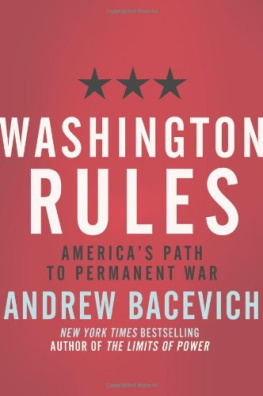
The author and publisher have provided this e-book to you for your personal use only. You may not make this e-book publicly available in any way. Copyright infringement is against the law. If you believe the copy of this e-book you are reading infringes on the authors copyright, please notify the publisher at: us.macmillanusa.com/piracy.
To my sisters and my brothers
with love and gratitude
and
To the memory of
Captain William F. Reichert
and
Colonel Theodore S. Westhusing
In the purer ages of the commonwealth, the use of arms was reserved for citizens who had a country to love, a property to defend, and some share in enacting those laws which it was in their interest, as well as duty, to maintain. But as the public freedom was lost in extent of conquest, war was gradually improved into an art, and degraded into a trade That public virtue which among the ancients was denominated patriotism derived from a strong sense of interest in the preservation of free government Such a sentiment could make but a very feeble impression on the mercenary servants of a despotic prince.
Edward Gibbon, The Decline and Fall of the Roman Empire
CONTENTS
PROLOGUE
Fenway Park, Boston, July 4, 2011. On this warm, summer day the Red Sox will play the Toronto Blue Jays. First, however, come pregame festivities especially tailored for the occasion. The ensuing spectaclea carefully scripted encounter between the armed forces and societyexpresses the distilled essence of present-day American patriotism. A masterpiece of contrived spontaneity, the event leaves spectators feeling good about their baseball team, about their military, and not least of all about themselvesprecisely as it was meant to do.
In this theatrical production, the Red Sox provide the stage, and the Pentagon the props. In military parlance, it is a joint operation. In front of a gigantic American flag draped over the left-field wall, an air force contingent, clad in blue, stands at attention. To carry a smaller version of the Stars and Stripes onto the playing field, the navy provides a color guard in crisp summer whites. The U.S. Marine Corps kicks in with a choral ensemble that leads the singing of the national anthem. As its final notes sound, four U.S. Air Force F-15C Eagles scream overhead. The sellout crowd roars its approval.
But there is more to come. On this Independence Day, the voice of the Red Sox booms over the public address system, we pay a debt of gratitude to the families whose sons and daughters are serving our country. On this occasion, the designated recipients of that gratitude are members of the Lydon family, hailing from Squantum, Massachusetts. Young Bridget Lydon is a sailorAviation Ordnanceman Airman is her official titleserving aboard the carrier USS Ronald Reagan , currently deployed in support of the Afghanistan War.
The Lydons are Every Family, decked out for the Fourth. Garbed in random bits of Red Sox paraphernalia and Mardi Gras necklaces, they wear their shirts untucked and ball caps backward. Neither sleek nor fancy, they are without pretension. Yet they exude good cheer. As they are ushered onto the field, their eagerness is palpable. Like TV game show contestants, they know that their lucky day has finally arrived, and they are keen to make the most of it.
As the Lydons gather near the pitchers mound, the voice directs their attention to the 38-by-100-foot Jumbotron mounted above the center-field bleachers. On the screen, Bridget appears. She is aboard ship, in duty uniform, posed belowdecks in front of an F/A-18 fighter jet. Waiflike, but pert and confident, she looks directly into the camera, sending a shout-out to family and friends. She wishes she could join them at Fenway.
As if by magic, wish becomes fulfillment. While the video clip is still running, Bridget herself, now in dress whites, emerges from behind the flag covering the left-field wall. On the Jumbotron, in place of Bridget belowdecks, an image of Bridget marching smartly toward the infield appears. In the stands pandemonium erupts. After a moment of confusion, members of her familysurrounded by camera crewsrush to embrace their sailor, a reunion shared vicariously by the thirty-eight thousand fans in attendance along with many thousands more watching on the Red Sox television network.
Once the Lydons finish with hugs and kisses and the crowd settles down, navy veteran Bridget (annual salary approximately $22,000) throws the ceremonial first pitch to aging Red Sox veteran Tim Wakefield (annual salarymodest for a big leaguer$2 million). More cheers. As a souvenir, Wakefield gives her the baseball along with a hug of his own. All smiles, Bridget and her family shout Play Ball! into a microphone. As they are escorted off the field and out of sight, the game begins.
What does this event signify?
For the Lydons, the day will no doubt long remain a happy memory. If they were to some degree manipulatedtheir utter and genuine astonishment at Bridgets seemingly miraculous appearance lending the occasion its emotional punchthey played their allotted roles without complaint and with considerable lan. However briefly, they stood in the spotlight, quasi celebrities, the center of attention. Here was a twenty-first-century version of the American dream fulfilled. And if offstage puppet masters used Bridget herself, at least she got a visit home and a few days offno doubt a welcome break.
Yet this feel-good story had a political as well as a personal dimension. As a collaboration between two well-heeled but image-conscious institutions, the Lydon reunion represented a small but not inconsequential public relations triumph. The Red Sox and the Pentagon had collaborated to perform an act of kindness for a sailor and her loved ones. Both organizations came away looking goodnot only because the event itself was so deftly executed, but because it showed that a large for-profit professional sports team and an even larger military bureaucracy both care about ordinary people. The message conveyed to fans/taxpayers could not be clearer: the corporate executives who run the Red Sox have a heart. So, too, do the admirals who run the navy.
Better still, these benefits accrued at essentially no cost to the sponsors. The military personnel arrayed around Fenway showed up because they were told to do so. They are already paid for, as are the F-15s, the pilots who fly them, and the ground crews that service them. As for whatever outlays the Red Sox may have made, they were trivial and easily absorbed. For the 2011 season, the average price of a ticket at Fenway Park had climbed to fifty-two dollars. A soft drink in a commemorative plastic cup ran you five and a half bucks and a beer eight dollars. Then there was the television ad revenue, all contributing the previous year to corporate profits exceeding $58 million. A decade of war culminating in the worst economic crisis since the Great Depression hadnt done much good for the country, but it had been strangely good for the Red Soxand an equally well-funded Pentagon. Any money expended in bringing Bridget to Fenway and entertaining the Lydons amounted to the baseball/military equivalent of pocket change.
The holiday festivities at Fenway had a further significance, one that extended beyond burnishing institutional reputations and boosting bottom lines. Here was Americas civic religion made manifest. In recent decades, an injunction to support the troops has emerged as its central tenet. Since 9/11 this imperative has become, if anything, even more binding. Indeed, as citizens, Americans today acknowledge no higher obligation.
Fulfilling that obligation has posed a challenge, however. Rather than doing so concretely, Americanswith a few honorable exceptionshave settled for symbolism. With a pronounced aversion to collective service and sacrifice (an inclination indulged by leaders of both political parties), Americans resist any definition of civic duty that threatens to crimp lifestyles.
Next page









